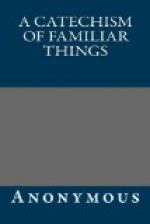What is Canvas?
A hempen cloth, so loosely woven as to leave interstices between the threads, in little squares. It is used for working in patterns upon it with wools, &c.; by painters for a ground work on which they draw their pictures; for tents, sails, and many other purposes. There are several sorts, varying in the fineness of their texture.
What is Damask?
A sort of silken stuff, having some parts raised on its surface to represent flowers or figures. It took its name from Damascus, in Syria, whence it was first brought.
Is there not another sort of Damask?
Yes, made from linen; and so called because its large flowers resemble those of damask roses. It was first made in Flanders, and is used for table linen, &c.
What is Flannel?
A slight, loose, woollen stuff, used for warm clothing; it was originally made in Wales, where it still continues to be manufactured in great perfection.
CHAPTER IV.
COCOA, TODDY, CHERRIES, BARK, CORK, COCHINEAL, CLOVES, CINNAMON, AND CASSIA.
Of what form is the tree which bears those large nuts, called Cocoa nuts?
It is tall and straight, without branches, and generally about thirty or forty feet high; at the top are twelve leaves, ten feet long, and half a foot broad; above the leaves, grows a large excrescence in the form of a cabbage, excellent to eat, but taking it off kills the tree. The cocoa is a species of Palm.
Is not the Indian liquor called Toddy, produced from the Cocoa Tree?
Yes, between the leaves and the top arise several shoots about the thickness of a man’s arm, which, when cut, distil a white, sweet, and agreeable liquor; while this liquor exudes, the tree yields no fruit; but when the shoots are allowed to grow, it puts out a large cluster or branch, on which the cocoa nuts hang, to the number of ten or twelve.
Distil, to let fall in drops.
Exude, to force or throw out.
[Illustration: THE CATHEDRAL OF MILAN, ITALY.]
How often does this tree produce nuts?
Three times a year, the nuts being about the size of a man’s head, and of an oval form.
Of what countries is it a native?
Of Asia, the Indies, Africa, Arabia, the Islands of
the Southern
Pacific, and the hottest parts of America.
What are the uses of this Tree?
The leaves of the tree are made into baskets; they are also used for thatching houses: the fibrous bark of the nut, and the trunk of the tree, are made into cordage, sails, and cloth; the shell, into drinking bowls and cups; the kernel affords a wholesome food, and the milk contained in the shell, a cooling liquor.
From what country was the Cherry Tree first brought?
From Cerasus, a city of Pontus, in Asia, on the southern borders of the Black Sea; from which place this tree was brought to Rome, in the year of that city 680, by Lucullus; it was conveyed, a hundred and twenty-eight years after, into Great Britain, A.D. 55.




